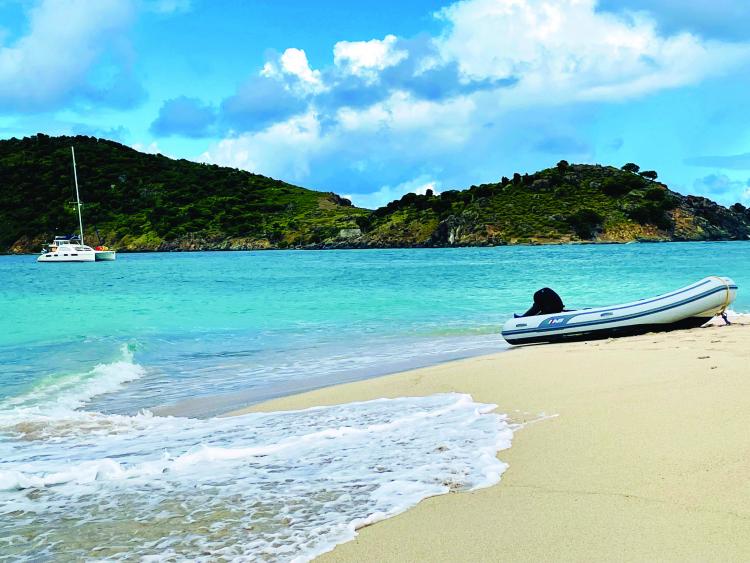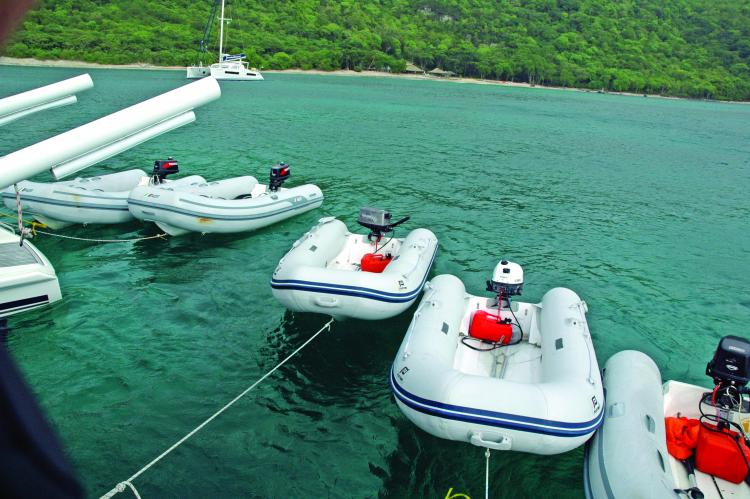Getting In and Out of Dinghies Is Not Easy… Here Are Tips for Charter Sailors
Chartering with newbies presents all kinds of challenges, even for a seasoned charter captain, but no single task is more important to master than using the dinghy as a crew commuter. Getting into and out of a dinghy may seem self-explanatory, but many times, even well-executed examples won’t help people who’ve never dealt with a rubber boat entry or exit.

Whether you’re dealing with a dock entry, hopping in/out from the big boat, splashing in from the water after snorkeling, or contemplating the dreaded beach landing, it’s all new to your crew. Provide as much guidance as possible, manage the situation to make it easier and less embarrassing and just bite your tongue and let them figure it out.
Transferring from/to the mothership
For some it may be intuitive or just a matter of a few tries, but for others, getting into a dinghy from the big boat may be a hurdle. Boats with platforms such as monohulls with a drop transom and catamarans with swim steps make it easier. If you can get the most agile one aboard first, have them hold the painter and maneuver the dink transom around (by hand or with the outboard) to position the entire side of the dinghy up against the platform. This creates the largest (and lowest) landing place. Be sure to provide enough slack in the painter to allow the person in the dinghy to hold on without being pulled over. Tell your group to get their center of gravity low and to never step on the tube before angling down onto the floor of the dink.
The real challenge is managing this process when a current is running. Especially on catamarans where water funnels between the two hulls, a fierce current can make holding onto the transom tricky. Don’t rush people, but instill in them a sense of urgency when the big boat is swinging or bobbing or when the current is especially fast.
Dealing at the dock
Much of the same process above comes into play at the dock. Additional challenges arise when the dock is high or wooden and can serve up splinters to knees or behinds. Floating docks in a surge or swell that are moving can be frightening, causing people to hesitate which is the last thing you need. Talk through the procedure before approaching a dock so that you spend less time dealing with issues when already connected. Always be the last one to check the tie-up, because untrained crew can get creative with knot tying. Leave a long painter so that other dinghies can get to the dock by pushing other boats out of the way long enough to load/unload.
Deep water entry
When snorkeling or swimming, it may be necessary to load into the dink from the water. This is seldom easy and never pretty. Unless your group has exceptional upper body strength, it’s best to bring a pair of fins in a couple of sizes, so each person can propel him/herself up with a mighty kick. Load one at a time and do it near the lowest part of the tube on the side. Don’t try to load using the outboard as a step—it’s slippery and sharp.
One strong person should get in first and then assist others. In particularly difficult cases, have one person pulling and another pushing from below (not easy) while the person making the ascent kicks hard and pulls with all his might. Most of these efforts result in a whale flop aboard and bring in lots of water.
Beach invasion
Beach landings can be calm or really exciting in case of a surf. First, if there is a swell or surf running, you may want to reconsider the idea altogether. Check to see if you can tilt the outboard out of the water before even getting close to shore; sometimes they’re stuck or heavy. Search for a place with a soft mud or sand landing. Rocks and gravel will make this doubly difficult. Judge the slope of the beach. Is it shallow so that the dink glides to a slow stop, or is it deep with a steep entry? If it’s the latter, your crew may be tempted to jump over the side too soon and will end up chest deep in the drink.
Aim the bow perpendicular to the beach, get a run at it, and just as you are about to land, cut the engine and pull it up. By now the crew on the bow should have slipped over the side, grabbing the painter and pulling the boat up the beach. The rest of the crew will need to get out to lighten the load. Beach landings are different every time. If you have kids, older folks, or particularly hesitant people, don’t attempt it. It’s not worth a twisted ankle.
You can lead your crew through the dinghy entry process, but you can’t make them stick the landing. Take it slow, provide examples and encouragement, don’t get hurt yourself while trying to help them, and never laugh. No videos allowed—it’s hard enough without an Instagram audience.
~By Zuzana Prochazka





